|
Updated Nov 18, 2006......................................................................................
Tahiti
September 19 – 20, 2006
Today we are on our way to Tahiti, which is one of the 120 French Polynesian Islands in one of 5 Archipelagoes.
Yeah.
What’s an Archipelago? I dunno. But according to Tahiti’s literature there are 5 circles around a bunch of different islands, and the caption is, “Archipel de la Polynesie.”
I think this means that Archie is from Polynesia. But it could also mean, “Archipelagos of the Polynesian,” which would suggest that archipelago means a group of islands. There’s some deductive reasoning for you. Tune in tomorrow for the same razor-sharp, intellectual dissection of the word, “isthmus” as in the radio broadcaster, “Isthmus in the Morning.”
Tahiti is a little less than 800 square miles (2,043 sq km) with a mountain of about 2,200 meters tall (about 1.3 miles). The actual island of Tahiti is the large round thing below; where we stayed was the little land mass called Tahiti Iti, around the 4pm area of the larger land mass, which is the smaller round thing below.
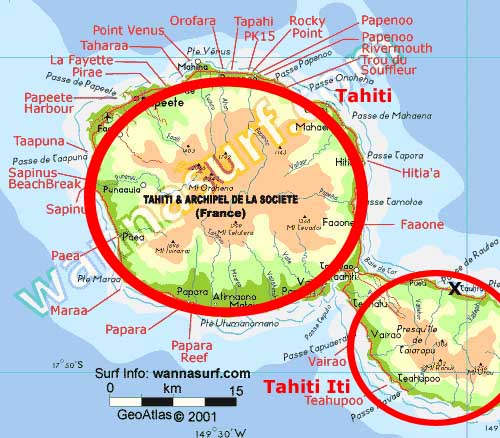
The positioning of these land masses actually brought up a good discussion between me and my lovely wife Nicky. I was driving, it was late, and I saw the Tahiti/Tahiti Iti map for about 9 seconds before I started driving. I had a rough understanding of where we were (Papeete, about 10:30 on the Tahiti landmass) and where we needed to be (about noon on the Tahiti-Iti map, which is shown by the large “X” on the smaller portion of the landmass).
As any red-blooded male knows when you refer to locations on a map, North is 12 o’clock and everything is referenced from that position. Standard practice for, uh…, just about everyone in the world. Except my lovely wife. She referenced the small land that connected Tahiti with Tahiti Iti as 12 o’clock, instead of the more appropriate ~10 o’clock. Man, it was late and I wasn’t sure of directions, and I couldn’t see the map, and I trusted Nicky for about 30,000 travel miles in the past 9 months so far as a competent navigator and driver, but she was way off this time.
For those of you in any doubt, 12 o’clock is ALWAYS up, or north; 6 o’clock is always south, or down. It doesn’t matter how one land mass joins another land mass, or what its feelings are for that land mass, or one landmass’s horoscope as compared to the other--12 o’clock is always 12 o’clock and that’s always up!
We crossed the International Date Line today. Or yesterday. Or tomorrow. Who can tell? Time Travel—it’s a cornucopia of conundrums. All I know is that I was able to celebrate “Talk like a Pirate Day” three times, officially celebrated on every September 19:
- On New Zealand Sept 19.
- On US Sept 19, which was New Zealand’s Sept 20
- We arrived in Tahiti at 8:30pm on Sept 19, so I was able to celebrate this vaunted holiday yet again for a wonderful 4 more hours.
Arrggh, Mateys. Ye filthy bilge rates. Methinks thar be somethin’ afoot. Ye be walkin’ the plank before the day is done…
Tahiti is a mountainous, volcanic island (so my lovely wife Nicky educated me this afternoon in painful detail). It’s also home to the typical, “tropical island corrugated tin and blue tarp housing.” We in the US have trailer homes and rednecks, and these are the source of endless jokes. In tropical islands it’s a lot of blue tarps and corrugated tin. Why not—they’re both cheap; keep the rain out, no insulation needed, fairly sturdy and easily replaceable. But they’re also a blight on the wonderful landscape, and oftentimes a shadow on the beauty that is the tropical island.
French Polynesia is the winner (so far) of the inane entry documents. If you’ve ever visited a foreign country, you know that they usually require some sort of entry document for passport control. This is usually something that asks questions like name, address, place of stay, length of stay, reason of visit, and passport info. Standard stuff.
But French Polynesia goes the extra mile. Not only do they ask these standard questions (which you have to fill in on the plane, in those empty block-style forms where you have to put one letter per block), they also made you re-enter the same information onto your entry visa, as well as fill out some sort of population survey information sheet.
Usually these entry forms take about 2-3 minutes per person to fill out. French Polynesian forms took about 25 minutes per person to fill out, which really almost wiped out all the time I saved (or lost?) by crossing the International Date Line.
To put this into perspective, I recorded some of the inane questions they asked on the “Marketing” form. For your interest, I’m including my answers. Like a good friend of mine (Hey Bob!), I like to mess with marketers’ heads. So far, I’ve entered the following into the OCCUPATION blank on these forms:
Welder
Wife
Mechanic
Chef
Data Entry Clerk
When I leave Tahiti and enter Easter Islands, I plan on being a Thoracic Surgeon. Then to Chile I will be a Deep Sea Diver. I suppose I should anticipate a late-night visit from the US State Department shortly after I arrive in the US because something alerted them of my ever-changing occupations…
September 20, 2006
We arrived at night at Pueu Village, about 12 o’clock in Tahiti Iti map (Nicky described it as 2 o’clock). It was pretty amazing that we found it because all the signs here are in a strange language. I think it’s French, but we can’t be sure. Here’s a typical conversation with Darren driving and Nicky navigating, it’s dark, it’s late, and we’re squeezed into a car the size of a lemon:
Darren: "OK, we just past a sign that said Pie."
Nicky: "How’s that spelled?"
Darren: "I dunno. We passed it too quickly and the high beams on this thing don’t work. Lemme slow down for the next sign. Ok, here it is. It’s Papara."
Nicky: ...pause... "I can’t find that on our map."
Darren: "OK, how about Passe Toprarara?"
Nicky: "Was that TopRarara? Or TopARara?"
Darren: "...ummmm…OK, next sign is..."
After spending the last 4.5 months in English speaking territory, I know that I was unprepared for the French culture shock. Plus our car was tiny (it was a Fiat Panda—huh?!); it was miniscule. I think it was the car that’s used on Monopoly boards it was that small. The car barely held our luggage and all the people. Nicky had to sit in the backseat with the kids and the front passenger seats were filled with bags.
So we arrived at Pueu Village around 10pm and Victor was there to meet us. He’s the owner and his website boasted of family hospitality. He showed us to our temporary lodgings for this night—apparently the cabin that we’d reserved was still occupied by someone that wanted to stay an extra night. No problems because Victor and his wonderful wife brought us a 6 pack of beer and some Tahiti juice. Dominique had a cup full of this juice and spit it out—apparently this juice is rum punch! And it was good stuff, so it didn’t go to waste.
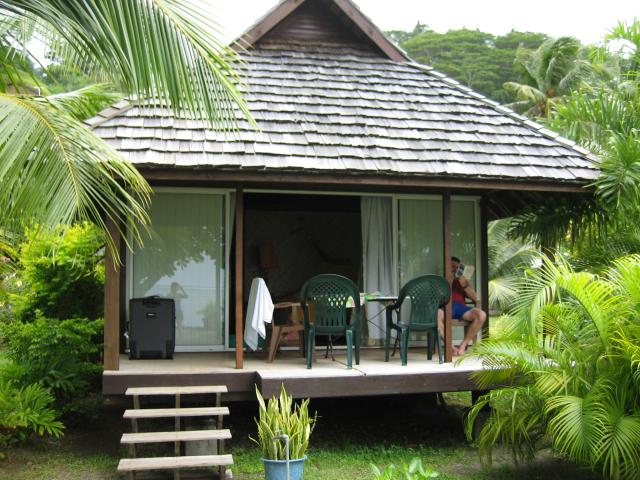
Being a volcanic island, Tahiti has black sand. That’s gross. Yet when you look at all the pictures that are included in their marketing brochures you see clean, white sand, huge beaches with palm trees swaying in the breeze. Here’s the real deal: their “beaches” are filled with black sand and riddled with trash. I don’t think they believe in public trash cans. Also their beaches are few and far between, and are very narrow.
And despite all my looking, I never did find the ultra-hot bikini-clad Polynesian waitress carrying a tray of piña coladas and frozen daiquiris.
Tahiti has 220 volt electricity, but their grounded plugs are a bit different. All their outlets have 2 female plugs, plus one male plug. So there’s no way that you can plug an ungrounded appliance into an outlet, nor is there a way to plug a grounded appliance into an ungrounded outlet.
Neat. And safe.
Tahiti has the worst money that we’ve experienced. The currency is the Pacific Franc (XPF) which is almost a 1 to 100 ratio with the US dollar. It’s tied to the Euro and during our visit it was 1 US$ to 98 XPF. Their coins are horrible. The 50 cent piece is about the size of a hubcap; I swear I saw it used as one of those over-sized key fobs that gas stations loan out to customers for the bathrooms.
The next strike against the Tahitian currency is that the 5 cent piece and the two cent piece are made of plastic. Seriously—they have coins made from plastic; it’s like carrying around a pocketful of MonopolyTM money (I want to be the car! Actually, I think we already rented the car).
Also there is no correlation between size and value (of course men will tell you the same thing…). Their 50 cent piece is the largest, then the 2 cent piece, then the dollar.
Lastly, they have more denominations of coins than any other country we’ve visited: 1, 2, 5, 10, 20, 50 and 100. Might as well throw in Pi as well, for cryin’ out loud…
Craziness I tell you…
September 21, 2006
We did a lot of hanging around here and let the girls run wild. Why not? The place was surrounded by a concrete fence to the road and water on the other side. They couldn’t run or get away.
The girls and I spent some time on the water.
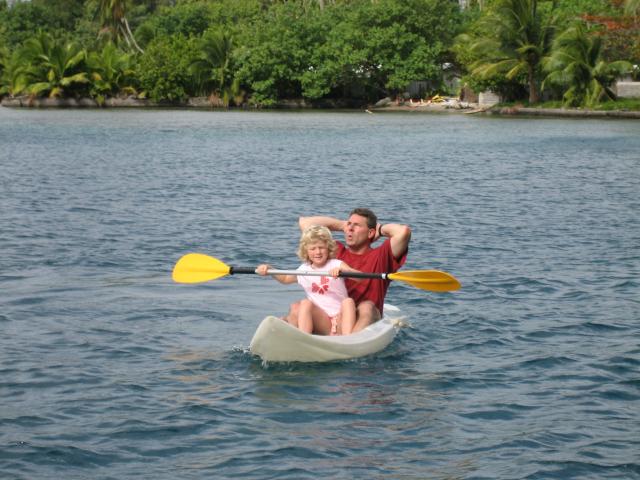
That’s some hard work I tell ya. And it takes some skill in order to keep it straight.
Then we went shopping for tonight’s dinner:
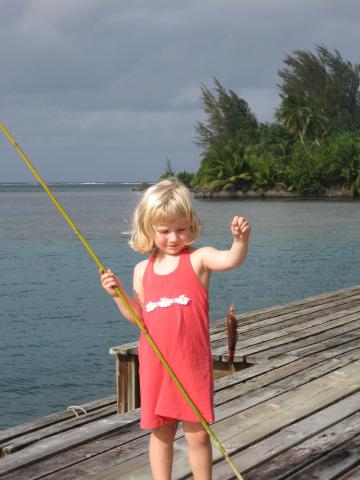
Video: Annette fishing
Note: if you can not see the video, download QuickTime and view the movie with it.

I’ve told Annette time and time again, we don’t keep anything under 6 inches…
September 22, 2006
Victor’s wife made the kids some dresses today, authentic Tahitian dresses. And they loved them. They wore them everyday we were here. They look great in them, and it was a wonderful gesture from her.
Video: Kids feeding the fish
I like these dresses because they’re nothing but a piece of material that’s cleverly folded/wound into some sort of clothing. It’s really easy and cheap to make, and really easy to clean, and really easy to fold. So from a parent’s perspective, it’s the perfect dress for girls.
September 23, 2006
We toured Tahiti Iti today. We were searching for, “The Plateau,” the high point on this part of the island that features a lot of their commercial agriculture, as well as astounding views.
Yes, this seemed to me to be antithetical. Commercial agriculture AND views? Pretty poor planning, eh? Apparently a lot of their fruit as well as their ubiquitous flowers are grown on this mountain. Yet we were undeterred by this apparent anomaly and were spurred on by an American couple from Mexico also staying at Pueu Village that said this was a good place to visit.
We got lost. Not only did we get lost, but we nearly got stuck on a less-than-car-width-track that we explored and couldn’t reverse or turn around. Luckily we were there with another couple and given the small size of our car (it’s a Fiat Panda with a one liter engine for crying out loud—what the hell is that?! My chainsaw has more power than this!) and the beefiness of the men (he wasn’t so large…), we got our car turned the right way albeit with a little less clutch and tire tread than when we arrived.
When we returned to our villa the Nice Lady (i.e. Victor’s wife, whose name we never knew) showed Dominique how to make a flower necklace.
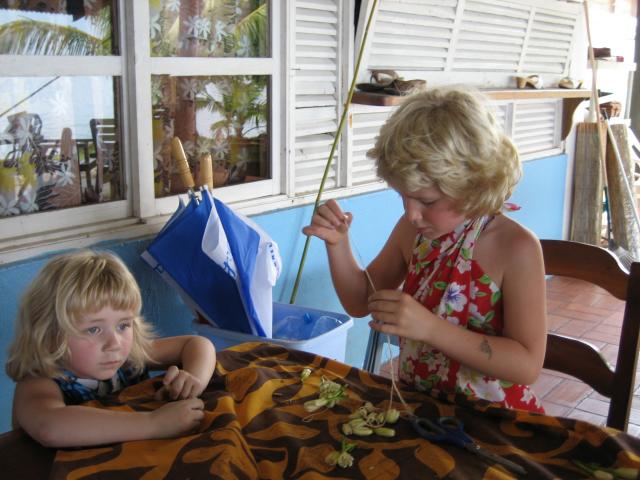
It’s deceptively simple, yet the finished product is really cool. These flowers are everywhere. And Dominique made her own necklace with no help from anyone, and she’ll go into business in the states if we can get flowers for her at the low price they have here. Either that or we’ll put her in the sweatshops in Indonesia, now that she’s trained.
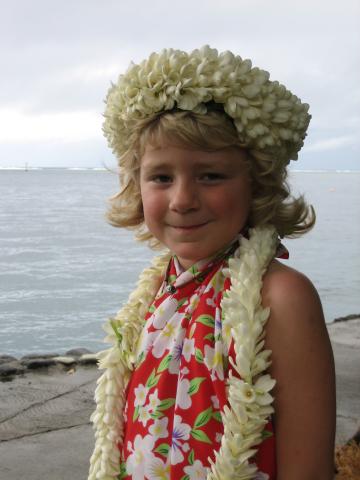
September 24, 2006
I got attitude served to me today; for the second time in Tahiti and at the same place. Major attitude.
We had to purchase goods to eat at a small convenience store. The big stores are closed on Sundays so I entered this convenience food establishment and searched for food. The pickings were slim, but even at the worst convenience stores you can find canned good or pasta stuff, which is what I got.
During my monetary transaction (about $12.57 roughly), the clerk had the energy to really ignore me, and actually talk to someone else during her, “ignore Darren” stage. I mean she really worked at ignoring me. This happened after I flashed my pearly whites and I gave her a heartfelt, loud, “Bonjour!”
There was disdain dripping from her fingers, a total sense of ambivalence flowed freely as she, very, very slowly, dropped my change on the countertop.
Wow. I’d rarely been the victim of such, “I don’t care” service. Had I been in the states, I would have retorted with an immediate and sarcastic, “How are you today? How’s your day been? Feeling good? Hope everything is well with you. Have a great day!” But there is a language and cultural difference here, and I’d just purchased bug-ridden pasta from her (there were bugs in the pasta, and the cheese was about one week out of date) so I thought I’d just leave it there.
If they’re not quick to correct this type of behavior, the French will soon get a bad reputation…
September 25, 2006
I had more attitude served to me today, and I didn’t leave a tip. But it was in a grocery store and I usually don’t leave a tip for the check-out person. But if it’s customary to leave tips for grocery store clerks in Tahiti, I would not have left anything.
I guess I showed that checkout girl, eh?
I did get good service and friendly conversation at our first gas station today. Apparently it is full-service here, which I appreciate because I couldn’t differentiate between the, “Petrol” and the, “Un-lead.” I knew the, “Diesel” wasn’t for us, but how was I to tell the difference between the other two? I need Petrol, but I need it of the Un-lead variety. There were no numbers signifying the octane rating, and the nozzles looked like they were the exact same size.
(NOTE: for those un-initiated in the petrol/gas world, the pumps are not only signified by the name of the gas, but usually by their octane rating, and to further make the fill-your-car-process idiot-proof, most pumps have different sized nozzles. If your car takes leaded gas, which older cars usually take, then the hole into your gas tank is very large which accepts a very large nozzle from the leaded-gas pump. Unleaded gas usually has a smaller diameter nozzle which snuggly fits into the smaller diameter gas tank. Diesel is just weird, and I can’t figure out any standards in that. We had a diesel car in South Africa and the diesel pumps seemed to be all over the place in terms of size, labeling, and numbers.)
(SECOND NOTE: Why does the octane rating matter? It matters because the higher the octane rating of a fuel, the more it costs. This is because the higher octane-rated fuels allow your engine to compress the air/fuel mixture more; the lower octane rated fuel may combust under the compression of the piston and cause the knocking noise, which is damaging to the engine. This is a rental car, so I don’t care at all about the damage to the engine, so we always put in the cheapest gas.)
But the dude at the petrol station here was friendly, and knew a little bit of English (he knew more English than I knew French), and we got along fine.
We continued to explore the area of life known as, “relaxation.” For some strange reason, the girls were content, nay happy, with the opportunity to play with the toys at Pueu Village and not bother us. And they didn’t get into trouble, and they didn’t ask for us to play with them, and they didn’t get hurt every 5 minutes. So Nicky and I just relaxed on the porch and enjoyed the breeze and caught up on our reading.
September 26, 2006
Victor offered us a short ride in his boat for the morning and we accepted. Apparently the idea of a short ride in Tahiti is much longer than a short ride in the States. The sun is burning here and I got a good bit of sun on the places where I didn’t put sunscreen, which is pretty much about everywhere. But it was fun being in the wind and water, and I appreciated Victor’s efforts at burning my skin.
We had a great Tahitian lunch with Victor, his wife, and the other couple they hosted. Notice the palm leaves dressed around the posts—very Tahitian. I was hoping for a couple of the young belly dancers to entertain us but apparently they don’t work on Sundays.
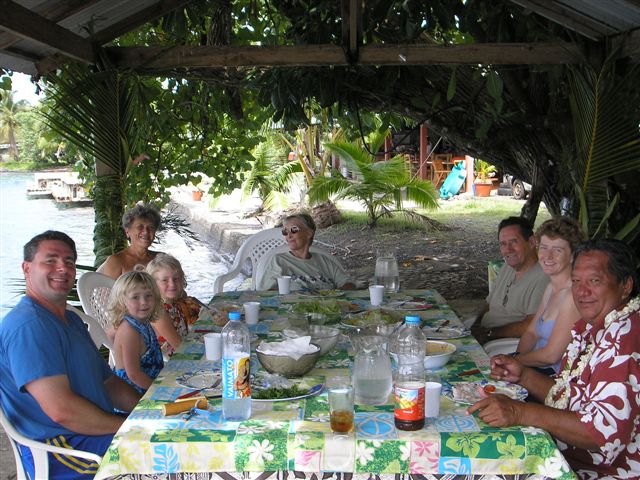
Today was our last day at Pueu Village, also known as Victor’s place. He’s great, his wife, affectionately known as, “The Nice Lady” is wonderful, and we’re a bit sad to leave.
So we moved from Victor’s place to Vanari Lodge today. This place, as a structure, is amazing.
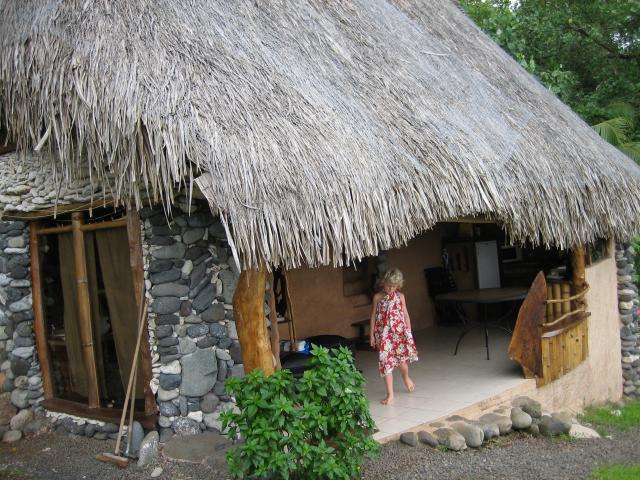
We’re staying in a place that’s really too cool, but not nearly cool enough. Please let me explain.
The architecture is world-class.
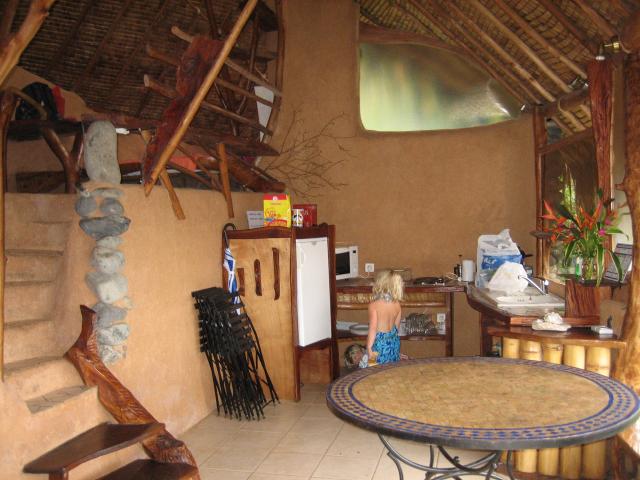
After staying in nearly 50 differently places in the last seven months in eight different countries, I think that we’re in a position to competently rate the qualities of lodgings, at least in the southern hemisphere. This place is amazing.
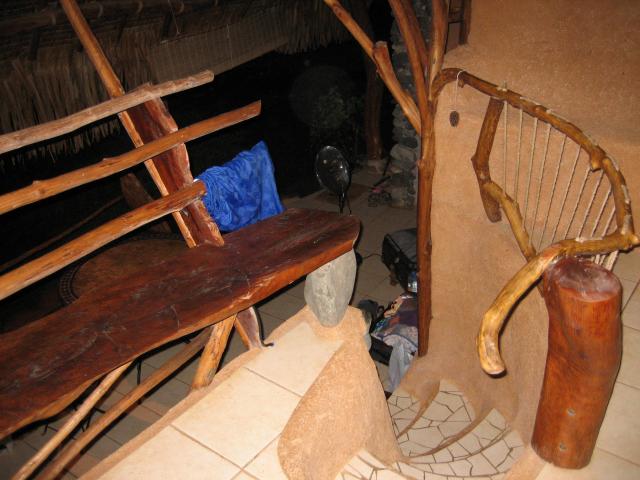
The views are wonderful. But it’s very still—no breeze, and it’s very warm. Not quite Thailand-hot, but very, very warm.
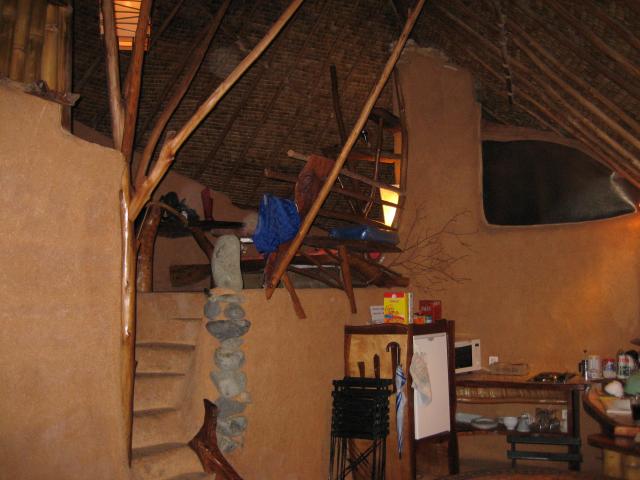
So, in sum, cool architecture, hot weather. Very hobbit-like house. I felt like I should be smoking from a long pipe, or not shave my feet.
I’m invoking my right as web-content maker and doing the rest of Tahiti as a story. So… uh… it rained a lot. We were warm. Me and the girls went in the pool one day. I found a place near the grocery store that had unprotected WiFi access and I tapped into it to get my email.
Oh, we found out that there’s a Leper colony on the island! They allow tours because their leprosy-infected people are now artists. We never could find it. I was quite bummed because I wanted to try out my leprosy jokes:
“Hey buddy, can you lend me a hand?”
“Please don’t do that, you could lose an eye that way.”
“What?! Have you lost your mind?! I mean your ear?! Again?!”
“Sam is still head and shoulders above everyone else. That’s because he still has his head and shoulders.”
That’s pretty much it. I really wanted to see the leper colony. I think they would have liked me there.
|